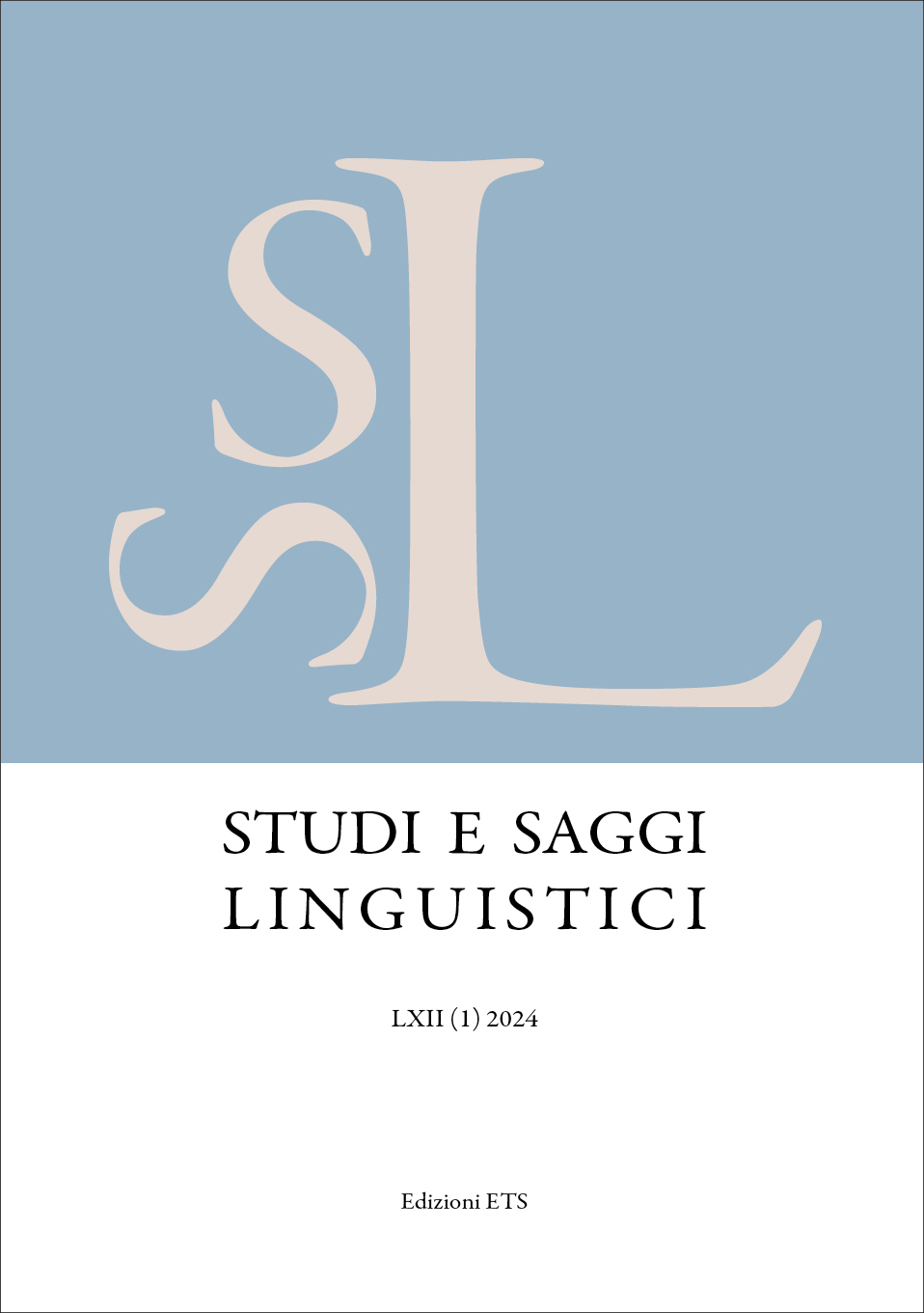Notes on geminatio consonantium in the Pelignan epigraphic corpus
Published 2024-07-11
Keywords
- Epigraphy,
- Ortographic reforms,
- Latin,
- Paelignan
Abstract
The Paelignian alphabet, like the one inherited from the Latins during the 4th-3rd century BC, did not originally distinguish graphically between weak and intense consonants. A careful analysis of the data from the Paelignian corpus reveals that the effects of the orthographic reform of the geminatio from Rome, which was spreading throughout the Latin community from the 2nd century BC, can also be found among the Paeligni. The close contacts over time between Latins and Paeligni, in the Abruzzi region, created a dense network of influences that is reflected in the epigraphic corpus of both languages. The graphic oscillations between geminated and weak forms found in the corpus of the Paeligni is to be understood as the result of a yet ‘imperfect’ or partial acceptance of the orthographic reform of the geminatio from Rome, mediated by the ‘dialectal’ or regional Latin environments.
References
- ADAMS, J. (2003), Bilingualism and the Latin Language, Cambridge.
- ADIEGO, I. X. (2012), Osco central y meridional frente a osco del norte (¿o más bien estandarización frente a no estandarización?), in «Mélanges de l’École française de Rome: antiquité», 124, 2, pp. 309-317, Roma.
- ADIEGO, I. X. (2016), Consideraciones sobre peligno anacet(h)a (i̯ demás variantes), in ANCILOTTI, A., CALDERINI, A., MASSARELLI, R. (a cura di) Forme e strutture della religione nell’Italia mediana antica, pp. 17-26, Roma.
- ALLEN, W.S. (1968). Vox Graeca: A Guide to the Pronunciation of Classical Greek, Cambridge.
- BERNARDI PERINI, G. (1983). Le “riforme” ortografiche latine di età repubblicana, in «AION», 5, pp. 141-169, Napoli.
- BUCK, D. (1904). A Grammar of Oscan and Umbrian: With a Collection of Inscriptions and a Glossary, Boston.
- BUONOCORE, M. (2002). L’Abruzzo e il Molise in età romana tra storia ed epigrafia, voll. I-II, L’Aquila.
- BUONOCORE, M. (2004), Supplementa Italica, 22, Roma.
- BUONOCORE, M. POCCETTI, P. (2013), Una nuova iscrizione peligna del gruppo «an(a)c(e)ta», in «Epigraphica», 85, pp. 59-106, Sassari.
- CAMPANILE, E. (1991), La mobilita personale nell'Italia antica, in CAMPANILE, E. (a cura di) Rapporti linguistici e culturali tra i popoli dell'Italia antica, pp. 11-21, Pisa.
- COLEMAN, R. (2000). The Contribution to Vulgar Latin in Italy from Other Languages in the Peninsula; Some Case Studies, in HERMAN, J., MARINETTI, A., & MONDIN L. (ed.), La preistoria dell'italiano: Atti della Tavola Rotonda di Linguistica Storica, pp. 23-40, Berlin, New York.
- CRAWFORD, M. H. (a cura di) ET ALII (2011), Imagines Italicae: A Corpus Of Italic Inscriptions, voll. I-III, London.
- DE VAAN, M. (2011). Etymological Dictionary of Latin. Leiden.
- DESBORDES, F. (1990), Idées romaines sur l’écriture, Lille.
- DUPRAZ, É. (2008), Des prénoms sabelliques aux prénoms latins en pays nord-osque, in POCCETTI, P. (a cura di), Les prénoms de l’Italie antique, pp. 111-132, Pisa-Roma.
- Dupraz, É. (2009), Hypothèses Sur Les Origines Du Si̯stème Gentilice En Pai̯s Nord-Osque, in POCCETTI, P. (a cura di), L'onomastica dell'Italia antica: aspetti linguistici, storici, culturali, tipologici e classificatori, pp. 319-339, Roma.
- DURANTE, M. (1962), Un fenomeno di sostrato italico nei dialetti centro-meridionali, in «Annali della Fac. di Magistr. di Palermo¬», 3, pp. 93-103, Palermo.
- JIMÉNEZ ZAMUDIO, R. (1986), Estudio del dialecto peligno i̯ de su entorno lingüístico, Salamanca.
- LEJEUNE, M. (1976), L’anthroponymie osque, Paris.
- MANCINI, M. (2019a). Repertori grafici e regole d’uso: il caso latino , in AGOSTINIANI, L. E MARCHESE, M.P. (a cura di), Lingua, testi, storia. Atti della giornata di studi in ricordo di Aldo Luigi Prosdocimi, pp. 13-53, Roma.
- MANCINI, M. (2019b [2020]), Sui frammenti ortografici di Lucilio: a proposito di alcuni lavori recenti, in «Atti del Sodalizio Glottologico Milanese», XIV, pp. 109-139, Milano.
- MARAS, F. D. (2020), Le scritture dell'Italia preromana, in «Paleohispanica», 20, pp. 923-968, Saragozza.
- MARINETTI, A. (1985), Le iscrizioni sud-picene, Firenze.
- MCCULLAGH, M. (2011), The sounds of Latin: Phonology, in Clackson, J. (ed.), A Companion to the Latin Language, pp. 83-91, Malden.
- MEISER, G. (1987), Pälignisch, Latein und Sudpikenisch, in «Glotta», 65, pp. 104-125, Köln.
- MIDDEI, E. (2015a), Gli antroponimi sabellici in *-ai̭os e le basi onomastiche con morfo-struttura acca-, in «Graeco-Latina Brunensia», 20, pp. 105-121, Brno.
- MIDDEI, E. (2015b), L’onomastica peligna tra variazione, identità e contatto, in «Studi e Saggi Linguistici», LIII, pp. 109-127, Pisa.
- MIDDEI, E. (2017), Le basi *ap(p)a- e *at(t)a- tra lessico e onomastica nell’ambito sabino, latino ed etrusco, in «Mediterranea», 14, pp. 82-101, Roma.
- ORIOLES, V. (1972), Fenomeni di palatalizzazione e di assibilazione nelle lingue dell'Italia antica, «Studi Linguistici Salentini», 5/1, pp. 69-100, Lecce.
- ORIOLES, V. (1995), Lega linguistica italica e palatalizzazioni, «Incontri Linguistici», 16, pp. 71-78, Pisa-Roma.
- PAULI, C. (1887). Altitalische Studien, vol. 5, Hannover.
- PISANI, V. (1954), Palatalizzazioni osche e latine, in «AGI», 39, Milano, pp. 112-119.
- PISANI, V. (1971), Ricognizioni osche e messapiche, in «ACSMGr», XI, pp., Taranto.
- POCCETTI, P. (2020), Lingue sabelliche, , in «Paleohispanica», 20, pp. 403-449, Saragozza.
- RIX, H. (1972). Zum Ursprung des römisch-mittelitalischen Gentilnamensystems, in TEMPORINI, H. (a cura di), Aufstieg und Niedergang der Römischen Welt. Vol. 1, 2, pp. 700-758, Berlin-New York.
- STUART-SMITH, J. (2004). Phonetics and Philology: Sound Change in Italic, Oxford.
- TAMPONI, L. (2022). La geminatio consonantium: studio su un corpus di epigrafi latine anteriori al I secolo d.C., in «Studi e Saggi Linguistici¬», LX (2), pp. 29-50, Pisa.
- UNTERMANN, W (2000), Wörterbuch des Oskisch-Umbrischen [= Handbuch der italischen Dialekte 3], Heidelberg.
- VON PLANTA, R. (1892), Grammatik der oskisch-umbrischen Dialekte, Strassburg.
